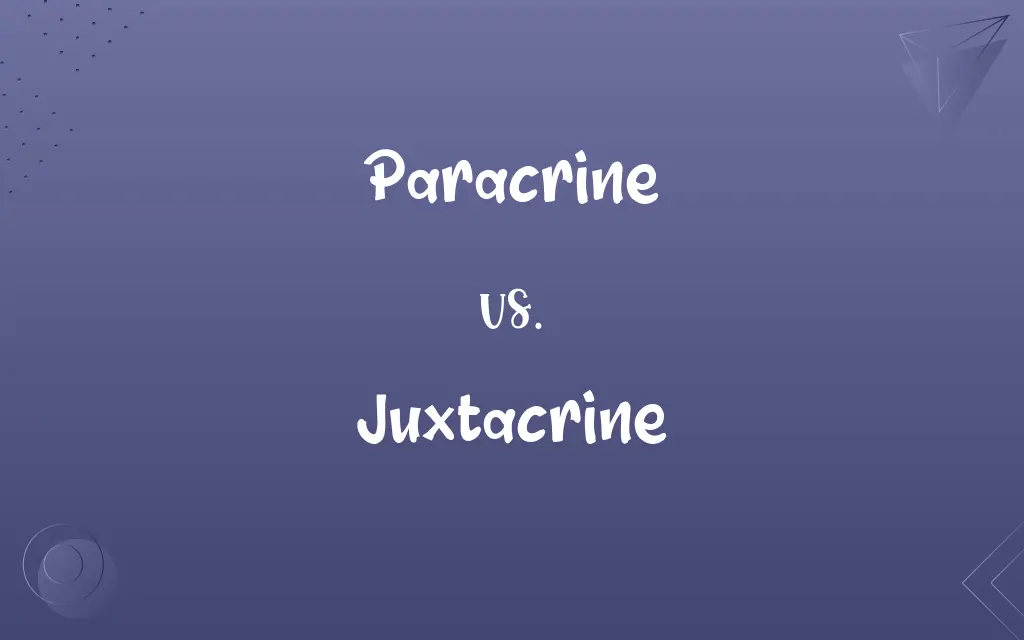Paracrine vs. Juxtacrine: Know the Difference

By Dua Fatima & Hifza Nasir || Published on September 7, 2024
Paracrine signaling involves distant cell communication via secreted molecules, whereas juxtacrine signaling requires direct contact between cells.

Key Differences
Paracrine signaling operates through molecules released by a cell affecting nearby target cells, thus facilitating local cellular communication. Juxtacrine signaling, in contrast, necessitates physical contact between cells, often through membrane-bound ligands and receptors, highlighting a more direct form of intercellular interaction.
Dua Fatima
Sep 07, 2024
The paracrine pathway allows for a broader influence, affecting multiple cells within a certain vicinity. This contrasts with juxtacrine communication, which is limited to adjacent cells, thus defining a more precise and localized signaling mechanism.
Hifza Nasir
Sep 07, 2024
Paracrine signals, like growth factors, can diffuse through extracellular spaces, reaching target cells. Juxtacrine signaling, however, depends on the structural integrity and proximity of cells, ensuring that signals are passed only to directly adjacent cells.
Dua Fatima
Sep 07, 2024
Examples of paracrine signaling include neurotransmitter actions in synaptic gaps, whereas juxtacrine signaling is exemplified by the interaction between immune cells and their targets. Each mechanism plays a crucial role in various physiological processes, including development, immune responses, and tissue repair.
Dua Fatima
Sep 07, 2024
Paracrine signaling can be modulated by the extracellular matrix and enzymes that degrade signaling molecules, juxtacrine signaling is influenced by cell adhesion and the physical arrangement of cells, underscoring different regulatory mechanisms.
Hifza Nasir
Sep 07, 2024
ADVERTISEMENT
Comparison Chart
Signal Transmission
Via diffusion through extracellular space
Through membrane-bound ligands and receptors
Dua Fatima
Sep 07, 2024
Regulation
Extracellular matrix, enzymatic degradation
Cell adhesion, physical cell arrangement
Hifza Nasir
Sep 07, 2024
ADVERTISEMENT
Paracrine and Juxtacrine Definitions
Paracrine
Paracrine signaling involves the release of molecules that affect nearby cells.
The release of histamine by immune cells triggers inflammation in surrounding tissue.
Dua Fatima
Feb 27, 2024
Juxtacrine
Juxtacrine signals are confined to the immediate cellular environment.
Embryonic development processes are precisely controlled by juxtacrine signals.
Dua Fatima
Feb 27, 2024
Paracrine
It operates over short distances, excluding the signaling cell.
In wound healing, fibroblasts produce growth factors that act paracrinally to stimulate cell division.
Hifza Nasir
Feb 27, 2024
Juxtacrine
It involves cell-to-cell communication through membrane-bound molecules.
The Notch signaling pathway is a classic example of juxtacrine signaling.
Dua Fatima
Feb 27, 2024
Paracrine
Paracrine signaling is modulated by enzymes that degrade signals.
The breakdown of acetylcholine by acetylcholinesterase prevents continuous neurotransmitter action.
Hifza Nasir
Feb 27, 2024
ADVERTISEMENT
Juxtacrine
It plays a key role in the immune response and development.
T-cell activation by dendritic cells is mediated through juxtacrine signaling.
Shumaila Saeed
Feb 27, 2024
Paracrine
Paracrine factors can diffuse through the extracellular matrix.
Neurotransmitters in the brain function paracrinally to transmit signals between neurons.
Hifza Nasir
Feb 27, 2024
Juxtacrine
Regulation of juxtacrine signaling occurs through cell adhesion.
Cadherins facilitate juxtacrine signaling by binding cells together.
Hifza Nasir
Feb 27, 2024
Paracrine
It's crucial for developmental processes by signaling cells to grow or differentiate.
Hedgehog proteins guide limb development through paracrine signaling.
Dua Fatima
Feb 27, 2024
Juxtacrine
Juxtacrine signaling requires direct physical contact between cells.
Immune cell activation often depends on juxtacrine interactions with antigen-presenting cells.
Hifza Nasir
Feb 27, 2024
Repeatedly Asked Queries
Can paracrine signaling affect distant cells?
No, paracrine signaling specifically targets nearby cells, not distant ones.
Dua Fatima
Sep 07, 2024
What is an example of a juxtacrine signal?
The Notch signaling pathway, crucial for cell differentiation and development.
Dua Fatima
Sep 07, 2024
What is paracrine signaling?
Paracrine signaling is a form of cell communication where cells release molecules that affect nearby target cells.
Dua Fatima
Sep 07, 2024
How does juxtacrine signaling work?
Juxtacrine signaling requires direct physical contact between cells, usually through membrane-bound molecules.
Hifza Nasir
Sep 07, 2024
What roles do paracrine signals play in the body?
They play roles in inflammation, wound healing, development, and cell differentiation.
Dua Fatima
Sep 07, 2024
Can the same molecule act in both paracrine and juxtacrine signaling?
Yes, depending on the context and the presence of specific receptors and cell contact.
Dua Fatima
Sep 07, 2024
Can paracrine signaling occur without direct cell contact?
Yes, it does not require cell contact, as signals diffuse through the extracellular space.
Dua Fatima
Sep 07, 2024
How do cells receive paracrine signals?
Cells have specific receptors that bind to and interpret the signaling molecules.
Shumaila Saeed
Sep 07, 2024
Why is juxtacrine signaling important?
It ensures precise communication and interaction between adjacent cells, important for development and immune responses.
Dua Fatima
Sep 07, 2024
What role does the extracellular matrix play in paracrine signaling?
It influences the diffusion and stability of signaling molecules, affecting the reach and duration of signaling.
Hifza Nasir
Sep 07, 2024
How is paracrine signaling regulated?
It is regulated by the extracellular matrix and enzymes that degrade the signaling molecules.
Hifza Nasir
Sep 07, 2024
What is the significance of cell adhesion in juxtacrine signaling?
Cell adhesion molecules facilitate the direct contact necessary for juxtacrine signaling.
Dua Fatima
Sep 07, 2024
How does the immune system use juxtacrine signaling?
It uses juxtacrine signaling for activation and regulation of immune cells, such as T-cells by dendritic cells.
Shumaila Saeed
Sep 07, 2024
Share this page
Link for your blog / website
HTML
Link to share via messenger
About Author
Written by
Dua FatimaCo-written by
Hifza Nasir







































































